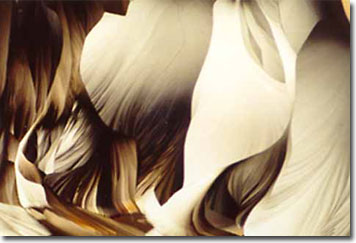Loes Modderman
Tartaric Acid-Sugar Mixture
Tartaric acid is a natural occurring, crystalline compound commonly found in tart fruits, unripe grapes, pineapples, and mulberries. When the juices of these fruits are fermented, a residual white crust of recrystallized tartaric salt forms along the inner surface of the container.

Potassium tartrate, the source of this white residue, is sometimes referred to as argol, or lees. Swedish chemist Carl W. Scheele discovered how to isolate the dicarboxylic acid using sulphuric acid, and this method of extraction, devised in 1700's, remains in use today.
A common ingredient in ceramics, photographic chemicals, and mirror silvering, tartaric acid is also utilized in tanning, and polishing products. In addition, sodium bicarbonate is used in combination with this white, powdery substance to enable quick dissolution of active ingredients in antacid preparations, as well as to put effervescent fizz in many popular beverages. As a component of baking powders, esters of tartaric acid impart a smoother texture to finished candies such as fudge and taffy.
Tartaric acid occurs in one of three salt forms: Cream of tartar, tartar emetic, and Rochelle salt. Interestingly, the crystals of Rochelle salt have electric properties (piezoelectric), and they are employed as part of the conducting components in some microphones. In purified form, tartaric acid produces crystals that typically have no smell, but possess a taste that is very slightly sour.
Although tartaric acid may be manufactured synthetically, a majority of the produce is obtained naturally as a by-product of the grape industry. Louis Pasteur (1822-1895), a noted scientist who conducted experiments using tartaric acid crystals, proposed that biological activities of chemical compounds are inherently related to their atomic composition and structural arrangement. Pasteur's painstaking investigations of the optical properties of these crystals, in fact, laid the foundations for modern day studies of stereoisomers.
Sugars occur in a wide variety of molecular formulas having unique ring systems, and they belong to a class of substances termed carbohydrates (for hydrated carbon). Typically sweet-tasting, these molecules are present in the sap of many seed plants, as well as in the milk of mammals. Sugars are widely used as refined tabletop sweeteners and syrups. In addition, they are common ingredients in candy, ice cream, confections, and soft drinks.
A molecule of sugar contains carbon atoms in combination with atoms of hydrogen and oxygen, and the typical ratio of composition is one carbon atom to a single water molecule (two hydrogens and one oxygen). In addition, carbohydrates commonly manifest in one of four major sugar groups: monosaccharides (one ring system), disaccharides (two ring systems), oligosaccharides (a few ring systems), and polysaccharides (many ring systems). Many monosaccharide sugars are prevalent in fruits, as well as in nectar or honey.
The simplest forms of sugar include molecules such as fructose, galactose, and glucose, which is also known as dextrose. Sugar compounds share the same molecular empirical formula, but have different atomic arrangements that account for their distinct characteristics. The three monosaccharides are actually isomers.
A normal component of animal blood, natural glucose does not require digestion prior to absorption in the bloodstream. Derivatives of fructose are also important in energy metabolism of many living organisms.
Double sugars, or disaccharides, which are formed by the union of two monosaccharides, include sucrose, maltose, and lactose, or milk sugar. Familiar sources of sucrose include beets and cane sugar. Maltose naturally occurs in high concentrations in seeds that have partially germinated, while dried mature barley seeds, referred to as malt, constitute the fermenting sugar ingredient commonly used in the manufacture of beer and malt whisky. Several monosaccharides and disaccharides are capable of donating electrons to other molecules, and they are able to act as important reducing agents.
BACK TO LOES MODDERMAN GALLERY
